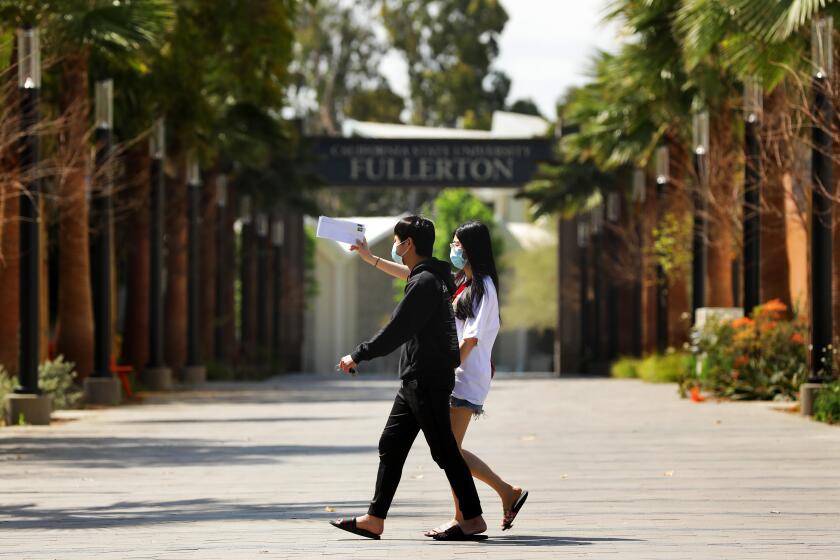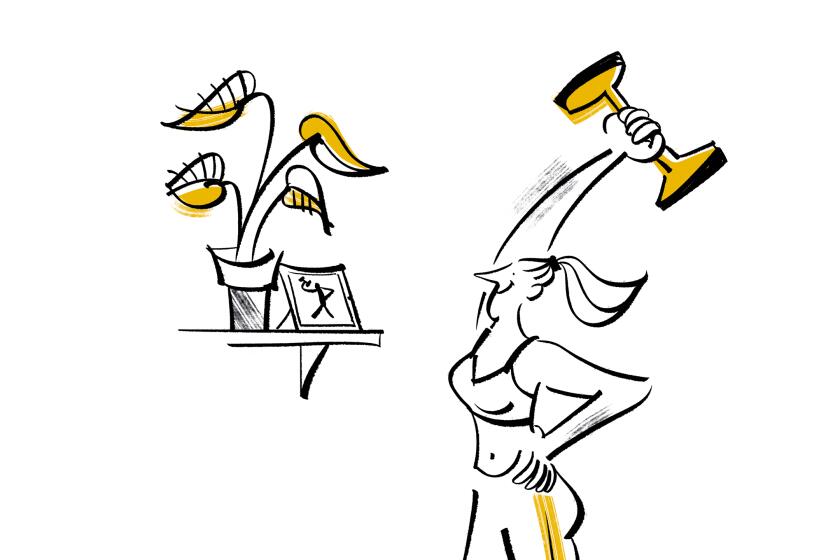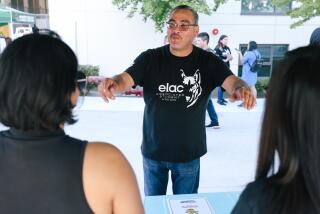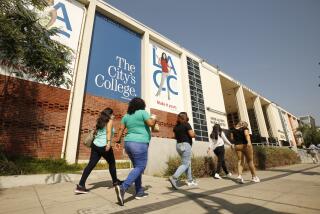College 2020: A day in the life of a socially distancing student
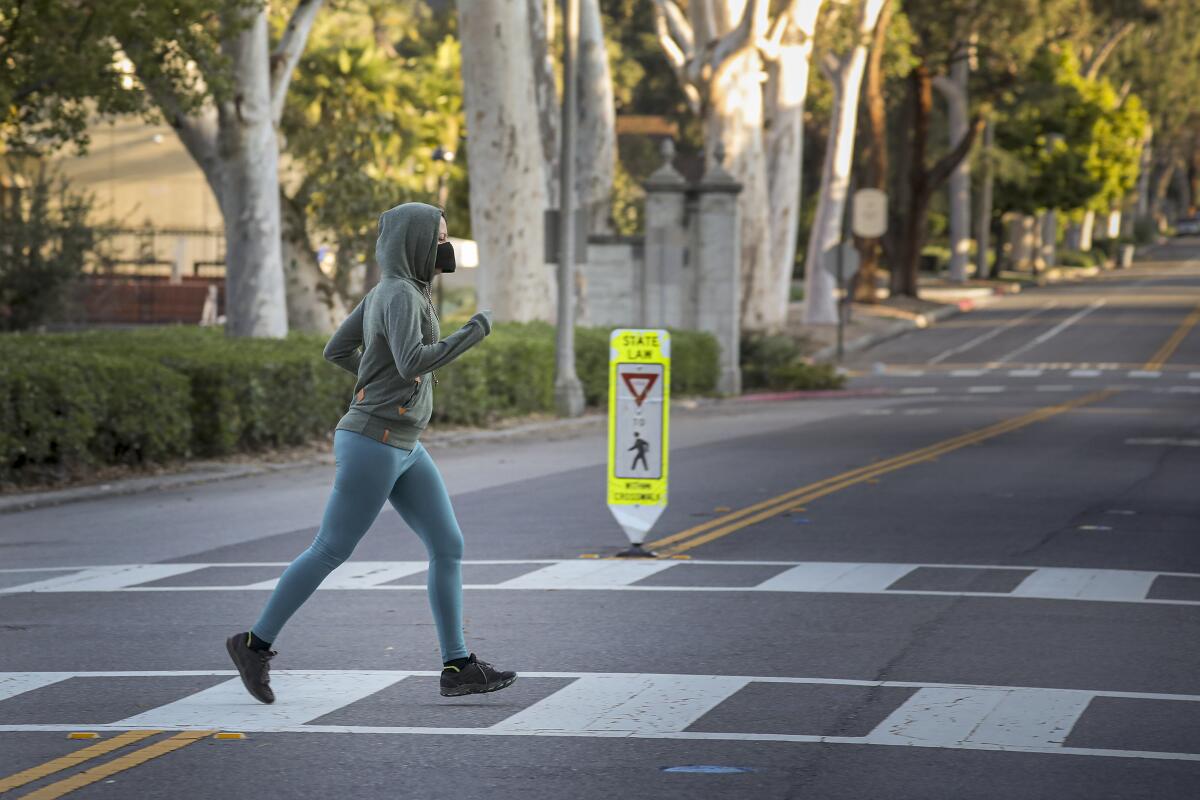
- Share via
Ravi and Priya Riley, twins from Los Angeles, have long imagined living in dormitories and attending freshman classes at UC Berkeley in the fall: roommates, packed lectures, all-night study sessions with friends.
But not all of their first-year expectations will materialize. Though Berkeley expects to hold some in-person classes this fall contingent upon low coronavirus case numbers, it will adopt physical distancing and cleaning precautions similar to schools around the country.
That, says Ravi, is preferable to distance learning.
“Staying online and staying home — I mean, you’re pretty much guaranteeing that you’re not going to have any semblance of whatever a freshman experience would be. Whereas with a hybrid system, maybe there’s a chance,” he said.
Administrators at Southern California schools say the details of student life on their campuses are still being finalized.
“We have 10,000 scenarios; we’re just not sure which one of the 10,000 is the one that’s going to be implemented,” said Michael Feltner, dean of Pepperdine’s Seaver College.
Based on interviews with administrators working on their own schools’ plans and on plans formulated by larger groups of schools, here’s what a day in campus life might look like come fall.
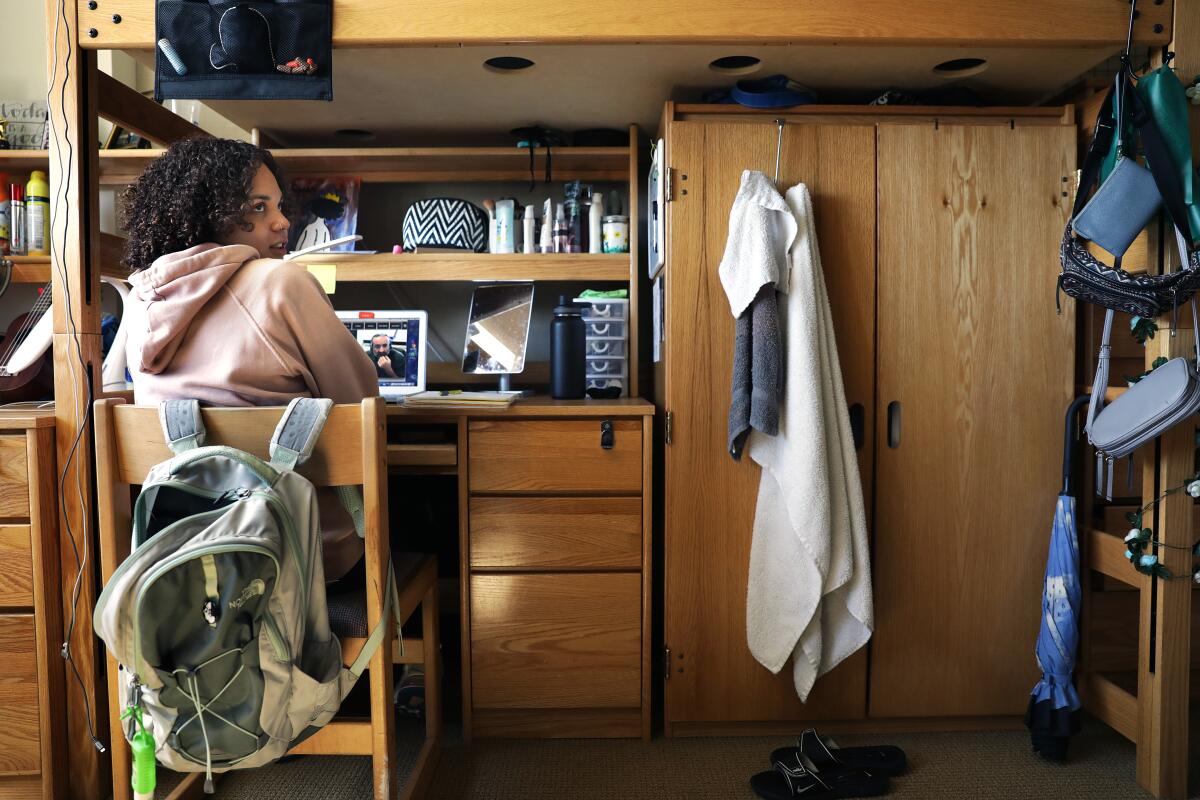
9 a.m.: Dorm room, hit snooze
Some students may not wake up in a typical residence hall. On-campus housing slots will run out as some dorms are converted to quarantine residences. To fill the gap, Pomona College, for example, is renting units at local apartment complexes. The school will determine by late July whether they will be able to move forward with housing students.
Dorms at Biola University in La Mirada will house no more than two students per room — no more triples. President Barry Corey doesn’t think Biola will have to deny housing to any undergraduates, but he anticipates more seniors will opt to live off campus.
Housing restrictions may also prohibit visits by students to other dorms. No sleepovers.
Last school year, you might have spent weeknights in a study room with poor circulation, surrounded by friends as you crammed for exams.
9:15 a.m.: Bathrooms
At many schools, an early morning trip to a hall bathroom will now require a face covering and cleaning wipes.
And students may have to wait to enter the facilities because their schools limit bathroom occupancy. Others will assign residents to a personal stall, keeping contamination to a minimum.
Once you’re in, you’ll use the wipes to clean the toilet seat, said Pomona College President Gabrielle Starr, who chaired a reopening task force for the 85-college Assn. of Independent California Colleges and Universities. Some schools may install automatic flushers, sinks and towel dispensers. And remember, “Wear a mask, even in the restroom. Not in the shower, obviously,” Starr said.
But for now, all dorm guidelines are only penciled in.
“It could be that we take the floor as something like a family unit. And then on the floor, masking would be not as tightly controlled. But if you left your floor, then you would definitely need to have a face covering,” Starr added.
9:35 a.m.: Walk to class
Registered for a 10 a.m. class? You may need to leave extra time to walk an alternative route. Many schools are creating one-way paths to keep students from breathing on each other.
Once you get to a building entrance, you might meet a nursing student, said Biola’s Corey, who leads a team advising Los Angeles County on how to reopen campuses. The student would scan your forehead with a noncontact infrared thermometer. If you’re within a normal range, they’ll transmit your results to an app on your phone so you don’t have to get tested again for a day or so.
As you head into your classroom building, you’ll catch a squirt of hand sanitizer (Biola has ordered 144 gallons).
But only some students will head into a building. Others may be meeting in a theater, garden or tent.
“A large class for us would be 50. That’s going to have to be split into two sections of 25,” Pepperdine’s Feltner said. “So we are seeking spaces. We are creating spaces. We will be taking spaces that haven’t been classrooms and making them classroom spaces.”
With classes in unconventional locations, students may have a longer distance to walk. This, paired with the need for less congestion, means colleges will increase break time between classes.
Some schools may greatly expand the course schedule. This may lead to scattered class times.
At Biola, the earliest classes will start at 7:20 a.m. and the latest will end at 10:30 p.m.
“Our campus has a wider band each day, and Saturdays as well, for courses. [Saturday courses] also limit the number of students that are going to want to go home or take off the weekend,” Corey said.
10 a.m.: Class time
The name of the game this fall will be “hy/flex courses,” Corey said. That means classes that are adaptable for in-person and online learning.
Some students will need to study solely online. International students and students vulnerable to the coronavirus should not be at a disadvantage in their coursework. Two-week quarantines may keep other students from the classroom.
At some universities, professors may choose to flip their classes entirely online or hold only small discussion groups in person.
A particular challenge for the Claremont Colleges is the inter-institutional offerings. While some students in the seven-college consortium can take classes at other campuses in typical semesters, that may not be feasible this year.
“This is a subject of discussion among all of the presidents right now,” Starr said. “And we also have one unusual part, which is we have some departments that are shared, for example, Africana Studies. There’s only one Africana Studies Department that’s shared by all the five undergraduate colleges.”

The 1918 flu was one the worst pandemics in history, infecting one-third of the world’s population. How cities responded to the crisis in 1918 provides lessons on handling COVID-19 today.
Noon: Grab a bite
Most schools will offer grab-and-go meals or food dished out by cafeteria staff. They’ll try to eliminate long lines and cafeteria crowding, so you will probably eat outside.
Connie Horton, Pepperdine vice president for student affairs, sees fall 2020 as a time to revamp dining options by adding food trucks around the Malibu campus. Self-serve dining would create opportunities for virus transmission.
“We don’t want people holding the same handle of the ladle,” she said. But “we want to think about the student experience too. We don’t want it to be ‘all the things you can’t do’ or ‘all the things you can’t have.’ Let’s make it fun. Let’s make it convenient. Let’s make it so there are variations.”
Many schools anticipate that student kitchens will remain available, as long as users keep countertops clean and refrain from sticking their hands in shared popcorn.
4 p.m. Activities and sports
Just like class time, you will be expected to follow physical distancing measures during extracurricular activities.
After 112 coronavirus cases were linked to one dance class in South Korea, it has become clear that indoor exercise classes and dance rehearsals will entail strict measures. They’ll require masks, while prohibiting partner dancing and contact improv.
Starr finds that unfortunate. She started dancing because it allowed for human-contact.
You can’t go to the gym, but you need to break a sweat and burn off the anxiety we’re all feeling. Here’s a variety of workouts that will do the trick.
“After I finished rugby with concussions, I was like, ‘What else can I do where I run into people, but more gently?’ And it was modern dance!” she said.
As schools adapt extracurriculars to health regulations, they’ll strategize to maintain the community-building benefits of the activities.
“What do we always want from the student life experience? We want a sense of community. We want a sense of fun, tradition, connection and student leadership opportunities,” Horton said. “We want to not lose sight of what we are trying to accomplish.”
A boon for California schools, she said, is the gorgeous weather. Some activities will move outdoors; in her opinion, it should have already been that way. And already-outdoor activities may be easy to accommodate.
“Surfing is probably good! Because it’s pretty independent, and it’s outside, and it’s in the water,” she said.
Another popular Pepperdine activity will thrive this fall.
“We also have a big esports program, which is thriving as we speak. They say introverts have been training for this moment. So have esports people,” she said.
6 p.m. Spirituality
Large religious events may not be possible. Pepperdine usually holds a weekly chapel service in the gym and other services in an amphitheater.
The university believes faith plays a vital role in education, so leaders are exploring new ways students can worship and grow. They plan to offer more faculty-led small-group discussions about books or Scripture. Biblical figures who are models of resilience seem particularly appropriate during a pandemic.
From Catholic churches to Jewish synagogues, Islamic mosques and other religious institutions, many of the faithful are being asked to adapt to changes to practices and rituals in the face of coronavirus.
Corey said that Biola’s over-1,000-person, student-led worship will not be possible this fall. Instead, he’s considering smaller services throughout the week.
“Maybe that’s what students need right now. Rather than a big, high-energy gathering, something that causes them to think and ponder more about life in the midst of a major disruption,” he said.
10 p.m.: Events? Parties? Nightlife?
Of all college activities, large events, parties and nightlife may take the biggest hit. But that doesn’t mean it’s all gone. Some large events will be split into several smaller activities. Other events will be held remotely or half online and half in-person.
“We’re imagining a coffee house, for example, where maybe the first 25 people who register get to see [the entertainment] live in a socially distanced theater setup, but then other people can watch it livestreamed,” Horton said.
Student leadership — especially sorority and fraternity presidents — will have a big role in adapting nightlife to the coronavirus.
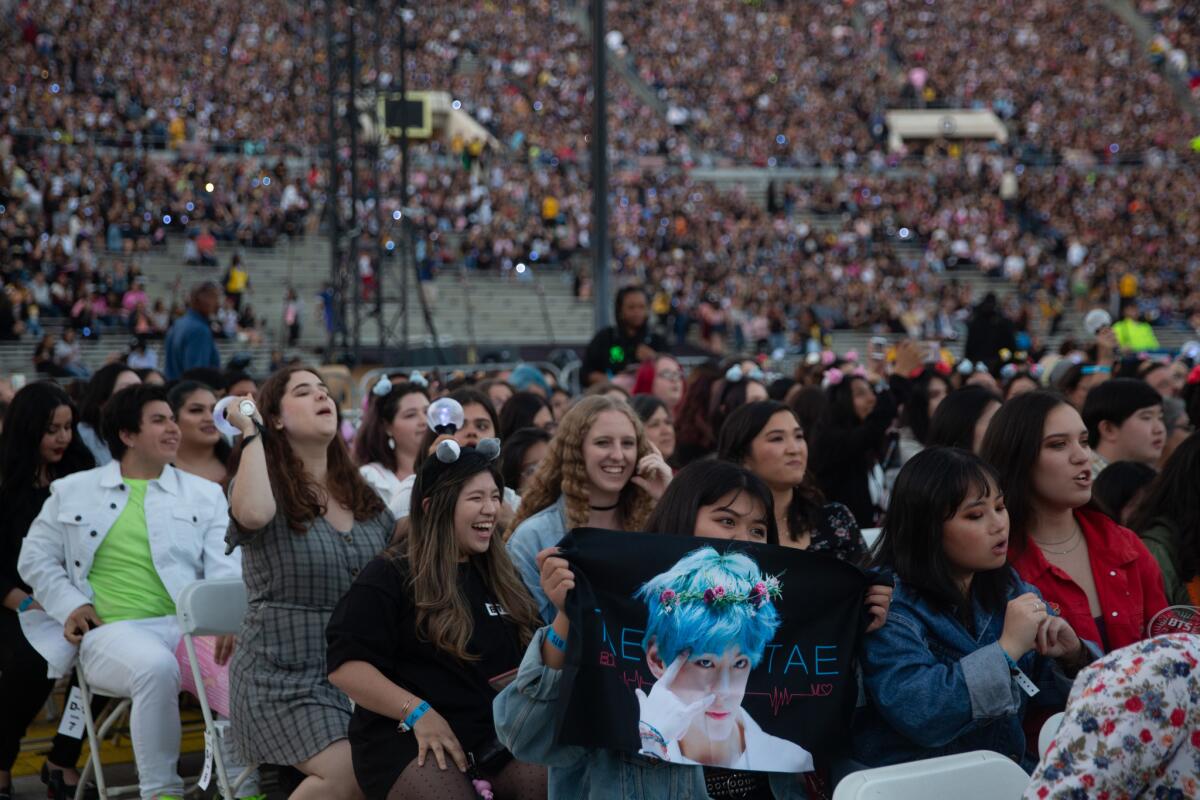
Starr said that social distancing may not be the only constraint.
“Alcohol and drugs make your judgment not so hot. You are much more likely to lower your inhibitions, to misunderstand the risk, and to overestimate your own abilities. I imagine that there will be some very tight zero-tolerance policies at a lot of places,” Starr said. “If you want to have a glass of wine in your room, you’re over 21, you are talking to a friend in your room, and you’re socially distanced, that’s probably OK. But a kegger is not.”
However schools and students adapt, administrators are enthusiastic for students to return to campus. Students look forward to seeing their friends and escaping their parents’ households.
“When I talk to students and I see the energy that they have and the excitement that they have to be back, it’s hard for that not to be infectious,” Feltner said. “That’s probably a bad word to use at this time.”
More to Read
Sign up for Essential California
The most important California stories and recommendations in your inbox every morning.
You may occasionally receive promotional content from the Los Angeles Times.
